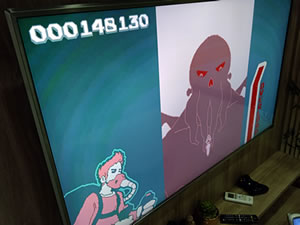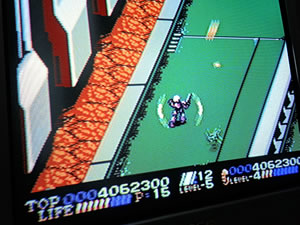Checkpoints OFF
4 Difficulty levels
5 Stages (loopable)
Ship speed fixed, selectable at start
- - - - - - -
Developed by Cave
Published by Arika in 2002
As we all know, the shmup way of gaming can be a fascinating ride. And the more we play these games the more we go down the rabbit hole of bullets and shooting styles. I say this because the Playstation 2 port of Dodonpachi Daioujou (also frequently written as Dai-ou-jou) was one of the first shmups I purchased when I started collecting, and by then little did I know about the game or this series as a whole. The first impression is still very fresh in my memory though: the game just felt impossible, an early realization that only melted after years of casual flirts and a steep learning ladder of dozens of other similarly cruel (yet most fulfilling) shmup journeys. That's why it feels so good to finally have looped of the game.
Since Dodonpachi II - Bee Storm was made by a different company, Dodonpachi Daioujou is Cave's true sequel to Dodonpachi. It greatly enhances everything that made Dodonpachi a success, including the difficulty. It's a game that's clearly tailored to the hardcore audience, with no concessions of any kind and a cruel challenge level that requires deep knowledge even in survival terms, let alone scoring. The port is based on the first iteration of the arcade game, commonly referred to as White Label (WL for short) and regarded by most people as being harder than the later board for Black Label (BL for short), which found its way to home consoles in the Dodonpachi Daioujou Black Label Extra release for the Xbox 360.
Being difficult, of course, doesn't mean the game is devoid of fun. Especially when you have a strong combination of exquisite graphic design and pumping music at the service of unabashed, pure gameplay intensity in a stellar port that's not only extremely faithful to its source material, but also full of additional tweaks and some alternate game modes.
The gameplay essence of the series remains the same: there's a button for shot, another for auto shot and a third one for bomb, all fully configurable. When using shot you fire a laser beam and move slower, and bomb animations differ whether you're using laser or shot (auto shot). What's new in Daioujou is the choice of ship, which is now restricted to types A (red) and B (green). After the ship is selected you must decide on its power emphasis, whether it's S (shot), L (laser) or E (expert): if S is chosen when you die you lose only one power level for shot while laser is reset to default, with L it's the contrary and E makes you lose only one power level for both. The caveat of expert is that you start with only one bomb in stock, whereas L gives you two and S gives you three bombs. Moreover, each death adds another extra bomb/bomb slot to the stock, limited to the number of bombs you have when starting (maximum of two slots for E, four slots for L and six slots for S).
How about hypering a little bit, buddy?
There seems to be a solid backstory to the choice between S, L or E power, in that each one is related to a so-called "element doll" that determines how the ship behaves in terms of weaponry. Shotia enhances shot, Leinyan enhances laser and Exy enhances both (at the expense of the bomb stock). The choice of element doll also applies minor changes to the ship's firing pattern or speed, which in turn are decisive on how advanced players approach the game.
Firing up a credit of Dodonpachi Daioujou is always a reason of joy due to the smart design of the first level. Graphics, colors and music serve the purpose of luring players while giving them the chance to learn the game's rhythm and basics. Common items are the well known P for firepower and B for extra bomb. Ship's hitboxes are very small, which allows you to squeeze them between seemingly impossible bullet curtains. Dodging bullets and blowing up stuff is of course a fun trait by itself, but if you do it in a certain way large numbers will start appearing on the top of the screen to indicate the hits in your "chain". To keep this chain going the player needs to kill enemies in succession without letting the vertical bar of the chain meter get empty. Hit count is then applied as a multiplier over the base value of everything you destroy, in what's clearly the backbone of the scoring system.
On the surface the chaining mechanics are unaltered from that of Dodonpachi, at least until you collect the first hyper and unleash its power. It's the main new feature implemented in Daioujou, a visually impressive boost of power that also gives you more hits per enemy and makes chaining easier. On the other hand, hypers make the game harder every time they're used, adding to the natural rank increase that's already in place for mere survival.
With the appearance of golden badges that come from the top of the screen and tail the ship once collected, hyper medals are generated based on your ability to chain and to point blank enemies. They supercede bomb usage, which means that pressing the bomb button activates your hyper stock instead of triggering a bomb. You can of course bomb during an active hyper, but then you cancel it on top of breaking your chain. While good as a survival aid due to the brief invincibility window it gives you upon activation, hypers also send enemy aggression through the roof while active. The risk/reward relation is clear: hypering is the key to higher scores, but it also makes the game tougher in the process. The number of hyper medals you have before hypering (maximum of five) determines the duration and increase in hit count of the hyper phase.
Besides chaining and hypering, other aspects of the game are also important for scoring in the long run. Each life in reserve at the end of the first loop is worth 10 million points, for instance. Every stage has 10 hidden bees unlocked with laser, and if you collect all of them without dying the last one will come with an extra ×2 multiplier, on top of increasing the base value of bees in the following stage. Adding another bomb to a full bomb stock displays the word "maximum" over the bomb display, progressively adding more points provided you don't die and don't bomb. Lastly, bonus stars of all sizes appear everywhere.
It's important to mention that the gameplay in Dodonpachi Daioujou goes a lot deeper that what I described above. Survival is already a huge challenge, but scoring makes the game even more elusive. The more you play the more you'll learn about the tiny details of how hypers are generated and behave, for example, as well as the consequences of using them in certain parts of the levels. Devising routes in order to better deal with the onslaught of enemies and bullets while trying to keep the chain going is always possible, but also increasingly difficult. Committing to the absolutely brutal difficulty and the strict demands of the chaining system isn't for everyone.
1st stage with type A-L and the arranged soundtrack
(courtesy of YouTube user Redd Arremer)
(courtesy of YouTube user Redd Arremer)
No matter how you look at it, brutal is indeed a fitting qualifier for this game. The difficulty spikes considerably from one stage to the next, already leaving unaware players in dread by the time stage 3 is reached. Three extra lives can be obtained, two by scoring (at 10 and 30 million) and one by destroying the huge cannon in stage 4 without bombing. As usual with every game in the series, a second loop can be accessed if you fulfill certain requirements in the first round, which in the case of Dodonpachi Daioujou are: maximum of two deaths, no more than three bombs used or all bees collected without dying in at least three stages. Not only is the second loop even crazier than the first in terms of difficulty, but all extra lives you have in stock are taken away so that you start it with only your current life. This means that a death in the first stage ends the credit, but if you manage to go on you'll get one life back for each level you complete. And at the end of the second loop extremely gifted players will finally face true last boss Hibachi.
The main mode in the Playstation 2 port is Arcade. In this mode it's possible to turn on replay saves before starting the credit, but strangely these saves work by level, not by the whole credit. A "no bullet" additional mode within Arcade can also be activated for learning purposes. Simulation mode is a thoroughly detailed and versatile practice area where you can also load your own replays or permanently saved super replays, taking over control at any moment. The final game mode is Death Label, which loads an infamous boss rush whose otherworldly difficulty defies everything you have ever imagined. The package is completed by two resolutions for TATE orientation, the option to turn on an arranged version of the soundtrack, mandatory save features, an art gallery and a map function with several wallpapers for YOKO displays. A special DVD with four superplays is also included in the PS2 release, so there's no doubt this is the full package for fans of the White Label variation of Dodonpachi Daioujou.
Since this game always represented a sort of wall for me with its ruthless difficulty and strict scoring rules, my objective was to simply beat it while conquering the access to the 2nd loop. I did learn how to confidently chain the first level and the second level to a lesser extent, focusing on survival for the rest of the game. I played in TATE in the Normal difficulty and my choice of ship was A-E (type A, Expert). My passport to the 2nd loop was collecting all bees without dying in the three initial stages.
Next for me is Black Label in the Dodonpachi Daioujou Black Label Extra release for the Xbox 360, then I guess I'll finally be ready to tackle Dodonpachi Daifukkatsu Ver. 1.5.









